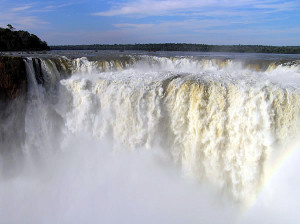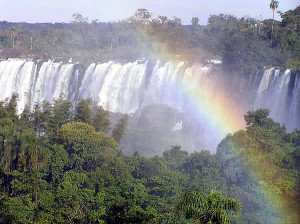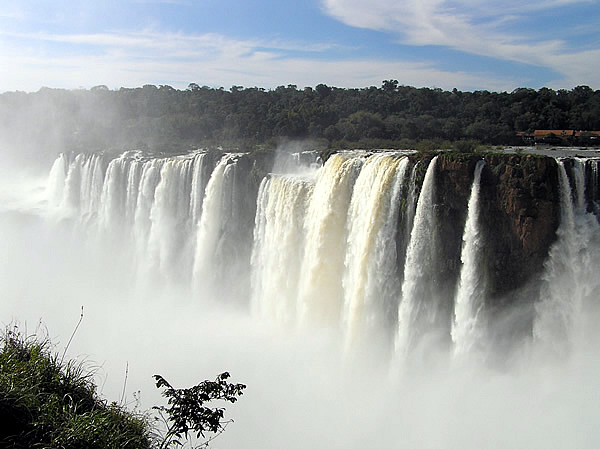This post is also available in:
![]() Deutsch
Deutsch ![]() Français
Français ![]() Italiano
Italiano ![]() Português
Português ![]() Español
Español
The Argentine side of the Iguazu Falls is located in the northeast of the Argentine province of Misiones, along the border with Brazil, 17 kilometers from Puerto Iguazú. To preserve the sub-tropical forest around the falls and the falls themselves, two national parks have been created, Parque Nacional Iguazú in Argentina and Parque Nacional do Iguaçu in Brazil.
The Parque Nacional Iguazú, which occupies an area of over 67,000 hectares on the Argentine side, was created in 1934.
In addition to the waterfalls, the area of tropical forest that surrounds them is also interesting. It hosts over 2,000 floral species, including ferns and orchids. 450 bird species have also been recorded, including toucans, urracas, teros, loros and vencejos, the latter species that lives only in the area of the Iguazú falls. There are also 80 species of mammals, including 5 species of felines, reptiles, and finally a huge number of insects including the colorful butterflies.
The park is open for visits from 08:00 to 18:00 between April 1 and August 31, and from 08:00 to 19:00 for the rest of the year. The entrance ticket costs $ 30 Argentine and includes the possibility of visiting all the paths along the falls, the use of the train in the area of the falls, the visit of the Centro de Visitantes, the visit to the Isla San Martín and Sendero Macuco.
[divider]
[divider]
WHAT TO SEE ON THE ARGENTINE SIDE OF THE IGUAZU WATERFALLS: THE MOST BEAUTIFUL ATTRACTIONS

The first visit to the Argentine part of the falls, immediately inside the park, can be made at the Centro de Visitantes. Here you can collect all the information necessary for the visit. Information regarding the history of human presence along the falls is also exhibited by the first men who populated the region, passing through the Guaraní, the Jesuits, the European settlers up to the current national park.
From the Central Station, the Train de las Cataratas transports visitors to the beginning of the paths and walkways that allow you to reach beautiful panoramic points on the waterfalls.
THE PATHS ALONG THE WATERFALLS
In the park there are several paths (Paseos) that allow you to observe the waterfalls from different angles:
PASEO INFERIOR
The Paseo Inferior, is a circular path of 1,200 meters, which allows the front and bottom observation of the waterfalls, at distances that vary from wide panoramas of the front of the waterfalls to close-up views of the Garganta del Diablo. The journey time of this path is two hours. The path is quite difficult due to the presence of gradients that are overcome by stairs. In total, the difference in height is what we will overcome by climbing the stairs of an eight-story building.
PASEO SUPERIOR
The Paseo Superior: it is a flat path, without stairs, of 1,100 meters (round trip). The walkways pass over the falls, reaching the edge of the jumps. This path allows a view from above of the falls. The travel time of this path is 1 hour.

GARGANTA DEL DIABLO
La Garganta del Diablo: this path can be reached by the Train de las Cataratas, getting off at the Garganta del Diablo station. From the station, you walk on level ground for a new walkway that, through a 1,100-meter path, reaches large balconies on the edge of the Garganta del Diablo. This is without doubt the most spectacular view of the falls. The travel time of this path is 2 hours. It is important to remember that the last train leaves at 16:30.
PASEO DE LA ISLA SAN MARTIN
The Paseo da la Isla San Martín: difficult path, you can reach the island through a free service of boats that leave from the Paseo Inferior. From here starts the path that reaches the upper part of the island of San Martin whose ascent is equivalent to climbing the stairs of a twelve-storey building.
SENDERO MACUCO
The Sendero Macuco: is a trekking path suitable for nature observation, through a path in the forest of 3,600 meters. Through this path you reach a 20 meters high waterfall in the middle of the forest.
[divider]
[divider]
This post is also available in:
![]() Deutsch
Deutsch ![]() Français
Français ![]() Italiano
Italiano ![]() Português
Português ![]() Español
Español



